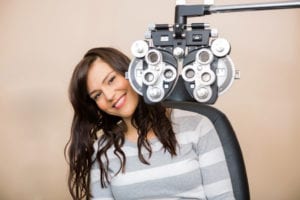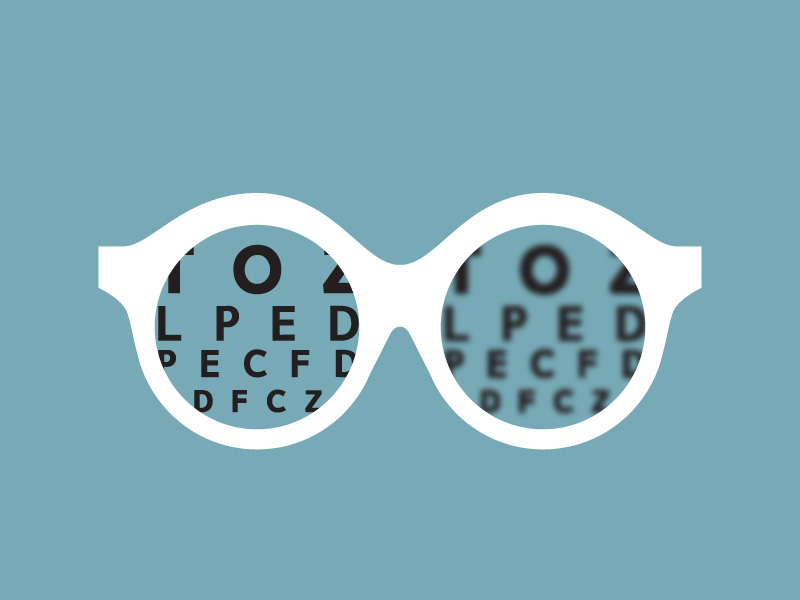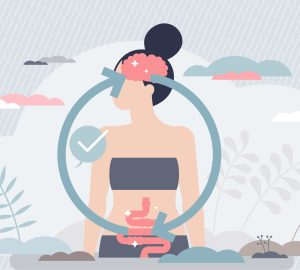a closer look
Annual eye examinations are recommended for children and adults, especially if they wear contacts or eyeglasses or have a family history of diseases that can affect vision, says Dr. Janae Kadlec, an optometrist at Eye Care Associates of St. Louis. While many don’t receive regular exams because their vision is not causing problems, Kadlec stresses the importance of checkups for early detection.
 “For most adults, we recommend an annual exam, but there are situations where you could go every other year if you don’t have a lens prescription and don’t wear contacts,” she says. “We like to see anybody who wears contact lenses every year to watch for related health problems. We also check the fit of the lenses and make sure the prescription is correct.”
“For most adults, we recommend an annual exam, but there are situations where you could go every other year if you don’t have a lens prescription and don’t wear contacts,” she says. “We like to see anybody who wears contact lenses every year to watch for related health problems. We also check the fit of the lenses and make sure the prescription is correct.”
Children should receive eye screenings in their pediatrician’s office until they reach school age, Kadlec says. “We recommend a general screening at 6 months and another at age 3 to rule out things like lazy eye or eye turns and to make sure pupils look normal,” she says. “The earlier these problems are addressed, the better the chance of having them fixed or strengthened so kids can be successful in school. At least 80 percent of learning in the classroom involves the eyes, so proper vision prevents delays in learning.”
Kindergarten should prompt the first annual examination by an eye doctor. “We look at distance and near vision and examine color and depth perception and eye muscles,” Kadlec explains. “Some research has shown that a basic screening can miss about one-third of vision problems because kids don’t know what they are supposed to be seeing or are used to using one eye to overcompensate for the other.”
surgical precision: lasik
The first eyeglasses were invented in Pisa, Italy, more than seven centuries ago, making it possible for people to correct bad vision with ingeniously shaped disks of glass. Now, Lasik offers surgical correction for visual deficits. It is estimated that 800,000 to one million people will undergo Lasik in the U.S. this year.
“We started the first clinical trials for Lasik in 1988,” says Dr. Jay Pepose, an ophthalmic surgeon at Pepose Vision Institute. “It’s what we would term a mature surgery now.” Lasik revolutionized human vision by providing a means of correcting, rather than working around, an eye defect. The procedure permanently changes the shape of the cornea, the clear covering of the front of the eye, by using the heat of a laser. Images are then better focused on the back of the eye.
For today’s baby boomers facing the normal age-related decline in visual acuity, Lasik is safer and vastly more accurate than in the past, Pepose says. “It is a very different procedure now,” he explains. “Before, we used a microkeratome, an instrument with an oscillating blade, to create a flap over the cornea. Now that is done with a laser, which allows us to program many aspects of the flap more precisely and has helped in terms of safety and recovery. There are complications in less than onetenth of a percent of procedures. The most common side effect is transient dryness until the nerves grow back, which takes a few months. People may have to use artificial tears.”
Accuracy also has been enhanced, Pepose says. Measurements are taken with WaveFront-guided treatment, which creates a 3-D map of the eye so the laser can accurately reshape the cornea. As a result, Pepose says, “Most people’s vision turns out better than what they had with glasses or contact lenses.” A recent study found that patients who had undergone modern Lasik had better night vision and fewer problems driving at night than those who wore contacts or glasses.
In St. Louis-area practices, Lasik for both eyes costs around $6,000, and many companies offer financing. “Most people spend money every month for contact lenses and solution, and glasses can cost $300 to $400 a pair,” Pepose notes. “Over 15 to 20 years, Lasik can be cost-effective in the long run.”
eye for fashion
If you must wear glasses, you might as well look good, too. Eyeglasses can be both a fashion accessory and a visual aid. Trichel Vahey, an optician at Eyewearhaus, says some patients have eyeglasses to match occasions and activities. “You might have a grab-and-go pair, but then have another for things like weddings or a night out. It’s like jewelry for your face,” she says.
Eyewearhaus stocks several thousand frames, Vahey says, but some may not work with certain lens specifications. “We look at the fashion aspect, but from the optician’s standpoint, it also has to be a good fit for the prescription,” she notes.
Next on the checklist is determining what the patient needs. “If you spend a lot of time in front of a computer, there are certain types of lenses, treatments and coatings that lend themselves to protection,” Vahey says. “If you are outdoors a lot, certain lenses can cut down on eye fatigue and sun exposure.”
Many find eyeglasses so flattering that they wear them even when a prescription isn’t required. Either way, Vahey says she is brutally honest with clients. “That’s what opticians do—we frame-style you,” she says. “Time and time again, patients thank us for helping them through the process and not letting them leave the shop with something that isn’t cosmetically appealing.”
how to choose the right frame
Highlight your natural features, like skin tone and the shape of your face. Get a frame that is the opposite shape of your face.
>> For a very round face, choose a rectangle.
>> If you have a heart-shaped face, pick a cat-eye.
>> For the most part, a square frame will not complement a strong jawline.
eye diseases
Regular examinations can reveal the early stages of eye diseases, which we typically can’t detect on our
own, Kadlec says.
glaucoma
>> A condition of increased pressure in the eyeball, causing gradual loss of sight
>> The risk increases as you get older.
>> It can damage the optic nerve and cause blindness.
>> A lot of people don’t feel the pressure or know something is wrong.
macular degeneration
>> The leading cause of severe, irreversible vision loss in people over age 60, it occurs when the small central portion of the retina, known as the macula, deteriorates.
>> It can cause blindness in adults.
>> Kadlec notes that risk indicators can be detected in younger adults. If caught, deterioration can be slowed and more significant problems can be avoided.
>> Exams are needed every two years if risk factors are known.
Undiagnosed diseases affecting other parts of the body often are discovered during eye exams as well, Kadlec notes. “The eye is the only place in the body where we can look directly at blood vessels and nerve tissue and get clues about health without an invasive or more involved procedure,” she says. Eye doctors can find evidence of:
>> Diabetes
>> High blood pressure
>> High cholesterol
>> Cancers like melanoma








